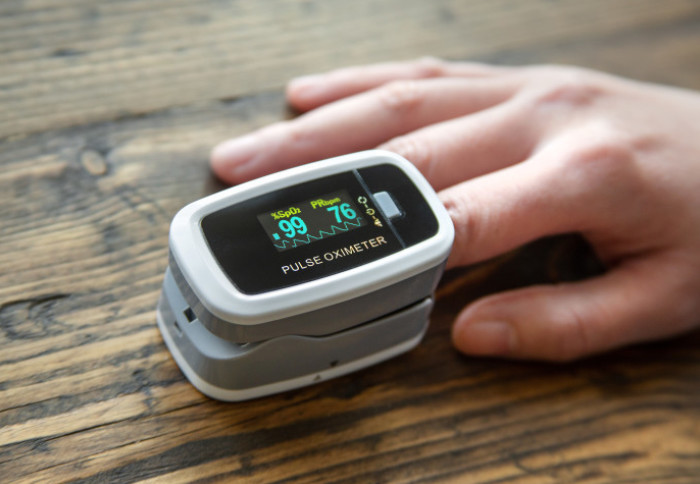National COVID-19 home blood oxygen monitoring programme delivered fairly

Evaluation of remote pulse oximetry monitoring programme shows that the service was preferentially used by patients with increased clinical risk.
The new research from Imperial College London, and published in The Lancet Digital Health, shows that a national COVID-19 remote pulse oximetry monitoring programme, known as CO@h, was preferentially used by patients with a known increased clinical risk.
During the COVID-19 pandemic, the NHS administered a pathway for at-home oxygen saturation level monitoring, as decreasing blood oxygen levels were found to be a critical indicator that a COVID-19 patient’s health is deteriorating, and they may need closer monitoring and urgent treatment.
Led by Imperial’s Institute of Global Health Innovation (IGHI), the study explored whether this pathway was administered equitably, addressing emerging inequalities associated with increased risk of mortality from COVID-19, including older age, socioeconomic deprivation and multimorbidity. The study found that of all those enrolled on the pathway; older people, those from minority ethnic groups, those from more socioeconomically deprived areas, or those diagnosed with one of several chronic medical conditions, were significantly more likely to be enrolled.
Providing pulse oximeters for at-home use meant an alert could be raised to a clinical team when levels requiring medical attention were reached, aiming to reduce the number of unnecessary emergency and hospital admissions for patients who could safely stay at home and reduce strain on already stretched resources. However, the research found that of the 1.2 million individuals testing positive for COVID-19 during the study period, only 1.6% of these patients were recorded as being enrolled on the programme. This is lower than the researchers and service providers were expecting and may indicate missing data or substantial barriers to implementation at a national scale.
"Our research has demonstrated that the administration of the CO@h programme was used preferentially by those known to be at an increased risk." Dr Jonathan Clarke Institute of Global Health Innovation
The study also showed that care home residents, a known vulnerable group for COVID-19, were less likely to be enrolled on the programme, which could raise concerns. However, it is likely remote monitoring with pulse oximetry was being implemented in care homes outside of the CO@h programme. There was variation in uptake of the programme across the country, so more research is needed to help understand why to guide future national-level monitoring programmes.
Study author Dr Jonathan Clarke, Sir Henry Wellcome Postdoctoral Fellow at the Centre for Mathematics of Precision Healthcare and Academic Clinical Fellow in General Surgery at IGHI, said: “Any new intervention should be implemented fairly, and our research has demonstrated that the administration of the CO@h programme was used preferentially by those known to be at an increased risk. However, some patient groups at high risk from COVID-19 were less likely to be enrolled, and future research is required to identify why this is the case.”
While telemedicine and remote monitoring offered the opportunity for many individuals to receive care at home during the pandemic, concerns were raised that not all groups benefit equally from these innovations. Many of the patient-related factors associated with barriers to effective use of remote monitoring are also associated with increased risk of mortality from COVID-19.
Enrolment into the programme also did not indicate whether the individual was able to successfully perform the required monitoring and reporting, and whether the CO@h programme was clinically beneficial. Two previous analyses found the programme had no considerable impact on all-cause deaths or hospital admission at a population level but found lower odds of death in COVID-19 patients clinically assessed in emergency departments. A further study by the group tracked changing trends in the risk of mortality and hospital admission following COVID-19 in 2.3 million adults in England.
Home monitoring using hand-held or wearable medical devices is relevant for other conditions such as heart failure and COPD, and as such could have the potential for additional implementation into health systems on an international scale.
Factors associated with enrolment into a national COVID-19 pulse oximetry remote monitoring programme in England: a retrospective observational study
Jonathan Clarke, Thomas Beaney, Ahmed Alboksmaty, Kelsey Flott, Hutan Ashrafian, Aidan Fowler, Jonathan R Benger, Paul Aylin, Sarah Elkin, Ana Luisa Neves, Ara Darzi
DOI: https://doi.org/10.1016/S2589-7500(23)00001-8
Image credit: Thomas Angus/Imperial College London
Article text (excluding photos or graphics) © Imperial College London.
Photos and graphics subject to third party copyright used with permission or © Imperial College London.
Reporter
Emily Medcalf
National Heart & Lung Institute